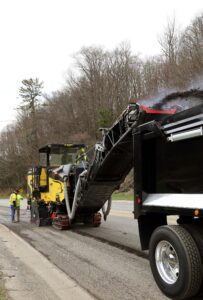
RAP: A solid part of the circular economy
By Adam Freill
Asphalt Construction RoadsAs one of the most recycled materials in North America, asphalt pavement is reducing reliance on virgin materials.
By weight, asphalt from roads is the most recycled commodity in North America, reducing the carbon impact of the roadbuilding industry and contributing to the circular economy while allowing contractors to deliver surfaces that match or exceed the performance of roads built without reclaimed materials.
“Asphalt pavement should be considered a green product because 100 per cent of asphalt pavement can be recycled,” says Alan Lichwa, asphalt and construction quality manager for Western Canada at Lafarge Canada. “Both components, asphalt binder and aggregates, can be reused in new asphalt pavements.”
The amount of Reclaimed Asphalt Pavement (RAP) permitted in a new mix varies from jurisdiction to jurisdiction in Canada, with some allowing up to 40 per cent, although comfort zones tend to be closer to 10 to 15 per cent, he explained. In addition to local regulations, Lichwa says the type of roadway being constructed, specifications being followed, and the availability of the recycled material are also factors.
“If the quality of the asphalt road being ground out is deemed to be questionable for re-use in new asphalt, it can be recycled within the granular base layer constructed beneath the roadways,” adds Mate Jurkin, GTA asphalt plants manager with The Miller Group, further illustrating the ways that paving firms can reduce their reliance on virgin materials. “The only exception where an asphalt roadway would not be recycled is if it is deemed to have a contaminated product.” These, he says, would be disposed of with utmost caution.
As pavement ages, the oxidizing binder becomes more brittle, so when using RAP, the loss of this flexibility in the old surface will impact the chemistry of the new mix.
“The challenge is to create a new asphalt pavement that is flexible using less flexible material,” says Lichwa. “This challenge can be overcome with the use of additives and different technologies that allow us to produce asphalt pavements with high amounts of recycled material.”
Where once concerns about the longevity and performance of roads using RAP were common, quality control measures and best practices are illustrating how the use of these recycled materials can create a road that meets or exceeds expected life cycles.
“With the proper additives and technologies, an asphalt pavement using recycled materials can outperform an asphalt pavement without recycled materials,” says Lichwa, adding that the percentage of recycled materials influences the other components in the mix, including the chemicals that help incorporate the recycled material.
Best practices are essentially the same whether reclaimed materials are used or not, however, both before the mix is created and after the roadway is paved.
“Best practice starts with a thorough pavement design, including analysis of traffic and climate data, to select the best type of mix for a road,” says Jurkin. “In order for the road to live to its long-term expectations it should undergo routine maintenance, such as crack sealing, and scheduled preventative maintenance.”
Lichwa adds that reducing and monitoring moisture in the recycled material, quality control testing on recycled material, and quality control testing on the final product are also practices that should be followed. As the use of recycled asphalt in roads has evolved, so too have industry specifications, testing and paving methods.
“We are moving towards more performance-based specifications, a different method of processing the RAP, use of asphalt cement rejuvenators, and more robust testing parameters,” says Jurkin. “It is more common internationally, but we may soon see cold-recycled mixes which make use of up to 100 per cent RAP and recycled with an asphalt emulsion at a mobile plant.”
“As a whole, the asphalt industry is changing not just because the addition of recycled materials,” says Lichwa. “There is a strong push for performance-based testing to be done on pavements to help quantify the effects of recycled materials… new technologies in asphalt mix design have changed how we understand asphalt mixes and help us design with high amounts of recycled materials.”
That’s good for the end customer, as well as for the environment.





